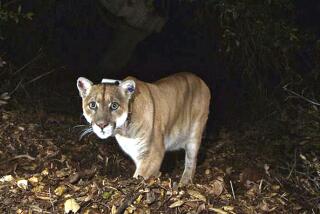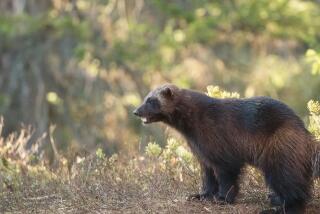Taming the Wild-Horse Program
- Share via
There may be a humane solution to the wild-horse problem in the West, but the existing program administered by the federal Bureau of Land Management is not it. The current wild-horse adoption program just is not working, and the bureau, knowingly or not, winds up either subsidizing the slaughter of unwanted horses--with the meat being sold for pet food or for human consumption abroad--or feeding the mustangs at taxpayer expense.
Romantic lore to the contrary, the wild horse is not exactly a part of the Western heritage, nor is it an endangered species. Many--primarily in California, Nevada and Oregon--are the offspring of animals set free back in Depression days by ranchers who could not afford to buy them hay or grain. They roam largely on federal land, and compete for grass with cattle and sheep grazed on the same land under lease from the Bureau of Land Management. In the old days the horses often were rounded up and sent to canning factories. Some merely would be shot. But the animals won protection under the 1971 Wild Horse and Burro Act, which established a system for adoptions.
Under the act, a family would pay a $125 adoption fee and have a horse that parents or children could ride. After a year the family would receive title to the animal. Some become rodeo stock, but the demand falls far short of the supply. Many of the horses are old and rangy and difficult to break for riding. And now, as The Times’ Ronald B. Taylor reported Monday, ranchers have concocted a way to obtain large numbers of horses from the federal government with the intent of selling them to slaughterhouses after the year’s wait for title.
The irony struck one Montana ranch wife who said that before 1971 enterprising cowboys would round up the horses and sell them to the canners. She added: “Now the horses go the same route, only it takes longer . . . and it costs (the taxpayers) more.” BLM Director Robert Burford said, “We can’t continue spending $17.8 million a year feeding horses in corrals.” One proposal under study is for nonprofit groups to buy land for the creation of wild-horse sanctuaries, although Congress could create such areas out of existing federally owned range land.
The wild-horse population has about doubled since 1971, to an estimated 43,000. Burford believes that a level of about 31,000 could be sustained without damage to the ranges. Perhaps American taxpayers believe that the annual cost of about $18 million is an acceptable price to pay for maintaining the horses, but surely the animals would be better off running free in a sanctuary than living in the confinement of corrals. But so long as the law reads the way it does, the government certainly should take steps to ensure that adopted animals are not doomed to commercial slaughter plants.
More to Read
Sign up for The Wild
We’ll help you find the best places to hike, bike and run, as well as the perfect silent spots for meditation and yoga.
You may occasionally receive promotional content from the Los Angeles Times.






